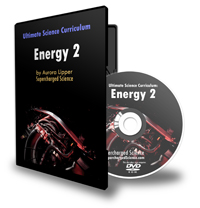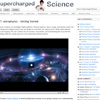Continues the journey into the field of energy by unlocking the mysteries of alternative energy, thermodynamics, and the earths resources. Students build a homemade weather tracker station, measure energy and power, make a fire water balloon, invent two working solar vehicles, learn how to bottle clouds, and construct a working external combustion engine from soda can parts.
Step 1. Click Here to download your copy of the Ultimate Science Curriculum Energy 2 Student Guidebook. To download the Parent/Teacher Guidebook, Click Here.
Step 2. Watch the videos that go with it below.
Lesson #1: Can solar energy be concentrated?
Overview: Today you’ll use a plain old light bulb to learn more about the special ways that the sun’s energy is used and harnessed, and especially the implications that it has on our energy needs.
What to Learn: This experiment will teach you how the sun’s rays interact with our planet, and how in turn we use this energy in a number of ways.
Materials
- Lamp with an incandescent bulb
- Magnifying lens
[am4show have=p121; guest_error=Guest error message user_error=User error message ]
Lesson #2: Solar Battery
Overview: This is a favorite experiment of mine, since it really demonstrates the photoelectric effect in a useful way. Here’s the deal: electrons can be either free or attached to the atom, and when you hit a metal place with UV light, some of the attached electrons break free and start current flowing in a circuit.
What to Learn: This lesson will help you learn how solar energy reaches the earth in the form of radiation and takes multiple forms, mostly visible light.
Materials
- ½ sq. foot of copper flashing sheet (check the scrap bin at a hardware store)
- Alligator clip leads (RS#278-1156)
- Multimeter (Radio Shack #22-810)
- Electric stove (not gas)
- Large plastic 2L soda bottle
- ¼ cup salt
· Sandpaper & sheet metal shears
Lesson #3: Solar Drinking Bird
Overview: The drinking bird is a classic science toy that dips its head up and down into a glass of water. It’s filled with a liquid called methylene chloride, and the head is covered with red felt that gets wet when it drinks. But how does it work? Is it perpetual motion? We’ll take a look at what’s going on with the bird, why it works, and how we’re going to modify it so it can run on its own without using any water at all!
What to Learn: You’ll learn more about the sun than about the bird itself, and especially about the sun’s influence on the Earth, air, and water.
Materials
- drinking bird
- silver or white spray paint
- black spray paint
- razor
- mug of hot water
- sunlight or incandescent light
Lesson #4: Can wind be used as a source of energy?
Overview: Construct your own windmill and use it to collect paper clips under its own power. In the process you’ll learn important concepts about alternative energy and the growing importance of renewable resources like wind power.
What to Learn: Pay attention to how the sun allows wind to form, and the importance of wind in our future’s energy needs and consumption.
Materials
- Pinwheel (can be purchased or made from construction paper)
- Paper clips
- Tape
- Small shoe box (children’s size)
- Electric fan
- Lightweight string (about 4 feet long)
- Plastic straw (longer than the width of the shoe box)
- Hole punch
Lesson #5: Wind Turbine
Overview: We’ll take a look at propeller design as we build a working wind turbine.
What to Learn: We use all kinds of resources to meet our energy needs. You’ll learn how wind energy is so important, and the principles behind how energy is converted so that we can use it.
Materials
- A digital Multimeter (Radio Shack #22-810)
- Alligator clip leads (RS#278-1156)
- 5-3V DC Motor (RS #273-223)
- 9-18VDC Motor (RS #273-256)
- Bi-polar LED (RS #276-012)
- Foam block (about 6” long)
- Scrap piece of wood for mounting
- Propeller from old toy or cheap fan or Radio Shack Solar Kit 277-1201.
- Sharp knife or scissors
- Hair drier
- Hot glue gun
Lesson #6: Can water be used to store energy?
Overview: Our sun can be used for all kinds of things. In our world that is suffering from an energy crisis, we need to be more proactive to address these needs. Did you know that large bodies of water are used to store heat? Find out how today!
What to Learn: This lab will allow us to see how water interacts with the heat energy of the sun. Remember the key terms we’ve learned so far: conduction, convection, etc. What type of heat transfer do we observe here?
Materials
- Paper cups
- Measuring cups
- Hot water
- Watch or clock
- Sink
- Refrigerator (with freezer compartment)
- Thermometer
Lesson #7: Fire water balloon
Overview: Heat energy can be observed in many ways. This simple experiment allows us to see how heat is transferred.
What to Learn: We’re exploring how heat energy can move between objects in a variety of ways.
Materials
- Balloon
- Water
- Matches, candle, and adult help
- Sink
Lesson #8: Balloon gymnastics
Overview: Heat causes all kinds of things to happen. We’ll zoom in on the micro scale of molecules as we explore in today’s lesson.
What to Learn: Heat energy influences all kinds of observable phenomena on our planet.
Materials
- water
- plastic bottle
- balloon
- stove top and saucepan or the setup in the video
Lesson #9: Ghost coin
Overview: This spooky idea takes almost no time, requires a dime and a bottle, and has the potential for creating quite a stir in your next magic show. The idea is basically this: when you place a coin on a bottle, it starts dancing around. But there’s more to this trick than meets the scientist’s eye.
What to Learn: Heat energy is carried through different substances and affects the properties of different types of matter
Materials
- Coin
- Freezer
- Plastic bottle (not glass)
Lesson #10: Whats a Joule?
Overview: Energy shows up in all kinds of ways. We’ll see how today through a simple lesson. What to Learn: Energy is the ability to do work. You’ll get practice playing with units and learning about how we measure energy and the forms it take. Materials
- Something that weighs around 100 grams or 4 ounces, about the same as an apple
- A meter or yard stick
Lesson #11: Measuring Power
Overview: Today you’ll measure power and have some handy tools to be able to record and interpret data. We use the same materials as last lesson, but introduce an important concept: that of power. Power is work done over time and is measured in watts, which is a Joule per second.
What to Learn: You’ll be able to have hands-on experience and understand a working definition of energy, work, and power.
Materials
- Meter or yard stick
- A stopwatch or timer
- Object
Lesson #12: Steamboats
Overview: This experiment provides a creative way to see how steam can provide power and offer us insight into how power is generated through this common means.
What to Learn: Many natural resources can meet our energy needs. We need to convert the energy stored in water into energy that we can use as electricity or heat.
Materials
- Copper tubing (1/8”-1/4” dia x 12” long)
- Votive candle
- Foam block
- Scissors or razor (with adult help)
- Bathtub
Lesson #13: Stirling Engine
Overview: The Stirling heat engine is very different from the engine in your car. When Robert Stirling invented the first Stirling engine in 1816, he thought it would be much more efficient than a gasoline or diesel engine. However, these heat engines are used only where quiet engines are required, such as in submarines or in generators for sailboats. You’re going to make one out of soda cans and old CDs.
What to Learn: A Stirling engine shows us how energy is converted and used to do work for us.
Materials
- three soda cans
- old inner tube from a bike wheel
- super glue and instant dry
- electrical wire (3- conductor solid wire)
- 3 old CDs
- one balloon
- penny
- nylon bushing (from hardware store)
- small candle or alcohol burner
- fishing line (15lb. test or similar)
- pack of steel wool
- drill with 1/16″ bit
- pliers
- scissors
- razor
- wire cutters
- electrical tape
- push pin
- permanent marker
- Swiss army knife (with can opener option)
Want More Science Activities?
These videos are samples from my online eScience Learning program. Its a complete science program for K-12. Plus, its self-guiding, so they can do it on their own.
Access over 800 more experiments! Includes our unconditional happiness money-back guarantee! Click here to learn more.
Thank You!
Thanks for the privilege as serving as your coach and guide in your science journey. May these videos bring you much excitement and curiosity in your learning adventure!
~Aurora
Supercharged Science
[/am4show]


